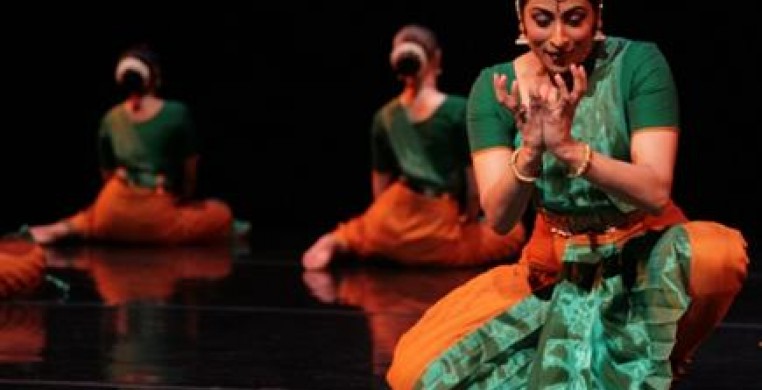Few practitioners of Bharata Natyam in Chicago have not passed through the hands of Hema Rajagopalan in one way or another. Founded in 1974, Rajagopalan’s company Natya Dance Theatre is largely considered to be one of America’s most prestigious Indian dance companies. Onstage at the Dance Center of Columbia College Chicago, Rajagopalan’s newest work “Varna: Colors of White” premiered last weekend celebrating Natya’s 40th anniversary season.
Many companies begin to show signs of decay after 40 years. Where others might choose to play it safe with old rep and revival casts for their ruby anniversaries, Natya’s ambitious, brand new, full-length “Varna” demonstrated a "go big or go home" resolve to continue as a key stake holder in creating classical Indian dance concerts. The young, vibrant cast was polished to a shine, smartly lit by Dustin Derry and beautifully costumed by Sandhya Raman. Featured principal dancer Krithika Rajagopalan must be noted for her magnetic solo performance, as well as the ensemble of musicians from Chennai, India performing an original score live onstage.
Based on ancient texts and poems, “Varna” examines the relationship between the spirit and the physical world in four distinct parts. The result was perhaps too ambitious, as what was supposed to be a 90-minute jaunt turned into 2+ hours of music, dance, and traditional Bharata Natyam storytelling. Admittedly (and perhaps shamefully), this was my first Natya show, so I have no idea whether or not it is customary or reasonable to keep audience members in their seats for nearly two and a half hours. Either way, by the time “Varna” reached its climax I just wasn’t that interested any more. It seems that maybe I wasn’t alone, as I witnessed a number of people exit the theater throughout the evening. Some came back, as we do in movie theater etiquette, quietly slipping out and in during a lull, but many who left did not return, perhaps as flummoxed as I was by the sheer length of the thing. I don’t know the norm in conventional Indian dance performances, but any given concert dance audience is rarely required to sit for more than an hour without a break. Bringing the house lights up a tidge during musical interludes could have provided a small hint that it was acceptable or even expected to come and go as one pleases, but that isn’t all.
Recognizing that the 30-minute jam session performed by the music ensemble was likely due to a miscommunication, “Varna” was largely inaccessible to audience members unfamiliar with Indian dance or the poems used as inspiration. In the press release, “Varna” is described as a work exploring “universal themes of love, sorrow, greed, desire and jealousy,” yet I found it difficult to uncover these themes given my admittedly limited exposure to Indian dance and music. Moreover, while love, sorrow, greed, etc. might appear universally, these emotions are felt and expressed differently across cultures. Though “Varna” was incredibly beautiful to behold, translations of the poems, or a chart in the program indicating the meanings of various mudras (hand gestures) would perhaps allow me to unpack this work on a deeper level than purely based on its aesthetics. As an example, featured dancer Krithika Rajagoplan’s captivating (though really long) series of mudras and storytelling was preceded by recorded English language text: “You promised to be with me, but all my dreams are gone…Why have you left? Do you know how I feel?” More hints such as this might have invited me into what I understand to be a deeply intellectual, highly intentional work.
It’s not that we must understand everything we see, however, my experience at Natya begs the question: who is their audience? Is the goal to appeal to a wider audience and cross-pollinate with other genres’ dancegoers, or is it to create work that will resonate deeply, but exclusively, to a smaller audience who will “get it?” I suppose the same question could be asked of avant-garde performance art or classical ballet, and if Natya’s longevity and widely respected reputation are any indication of their success, it probably doesn't matter whether they appeal to the masses, or to me.

